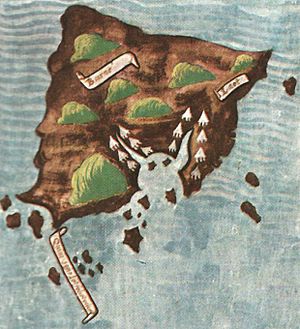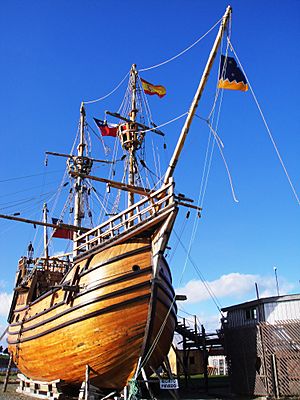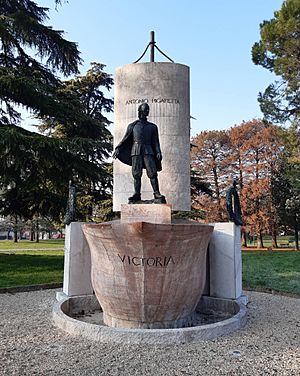Antonio Pigafetta facts for kids
Quick facts for kids
Antonio Pigafetta
|
|
|---|---|

Statue in Cebu City
|
|
| Born | between 1480 and 1491 |
| Died | c. 1531 (age about 40–50) Vicenza, Republic of Venice
|
| Nationality | Venetian |
| Years active | 1500s–20s |
| Known for | Chronicling Magellan's circumnavigation |
Antonio Pigafetta (born around 1491, died around 1531) was an Italian scholar and explorer. He is famous for joining the first voyage around the world. This amazing journey was led by Ferdinand Magellan.
Pigafetta was one of only 18 men who completed the entire trip. They returned to Spain in 1522, three years after they started. About 240 people began the journey. These brave sailors were the first to sail all the way around the world!
During the trip, Pigafetta worked as Magellan's helper. He kept a very detailed journal. This journal helped him learn the Cebuano language spoken in the Philippines. His notes are the first written record of that language. Pigafetta's journal is also the main source of information we have about Magellan's incredible voyage.
Later, in 1931, a warship of the Italian Royal Navy was named after him. It was a destroyer from the Navigatori class.
Contents
Early Life
Antonio Pigafetta's exact birth year is not known for sure. Historians think he was born between 1480 and 1491. If he was born in 1491, he would have been around 30 years old during Magellan's expedition. This age seems more likely to historians.
Pigafetta came from a wealthy family in Vicenza, a city in northeast Italy. When he was young, he studied important subjects like astronomy, geography, and cartography (map-making).
In the early 1500s, he served on ships belonging to the Knights Hospitaller. Before joining Magellan, he also traveled to Spain with a church official named Monsignor Francesco Chieregati.
Voyage Around the World

In Seville, Spain, Pigafetta heard about Magellan's plan to sail to the Spice Islands. He decided to join the expedition. He was given the title of "supernumerary" and a small salary.
The voyage began in August 1519. As they traveled, Pigafetta carefully wrote down everything he saw. He collected lots of information about the geography, climate, flora (plants), fauna (animals), and the people they met.
His detailed notes were very important for future explorers and map-makers. This was because he included useful information about sailing and languages. Historians today also find his journal valuable because it's so vivid and detailed. The only other sailor who kept a journal was Francisco Albo, the pilot of the Victoria ship. He kept a formal logbook.
Return Home

Pigafetta was hurt on Mactan in the Philippines. This was where Magellan was killed in a battle in April 1521. Luckily, Pigafetta recovered from his injuries. He was one of the 18 survivors who continued the journey with Juan Sebastián Elcano. They sailed back to Spain on the ship Victoria.
They arrived in Sanlúcar de Barrameda, Spain, in September 1522. This was three years after they had left! Pigafetta then returned to his home in the Republic of Venice.
He wrote about his amazing experiences in a book called "Report on the First Voyage Around the World." The original title in Italian was Relazione del primo viaggio intorno al mondo. He wrote it in Italian. Copies of his handwritten report were shared with kings and queens in Europe. It was later published by an Italian historian in the mid-1500s.
Pigafetta's report focused on the events in the Mariana Islands and the Philippines. It also included several maps of other areas. It even had the first known use of the words "Pacific Ocean" on a map! Sadly, the original handwritten document of his report has not survived.
However, Pigafetta's writings were not the first way Europeans learned about the trip around the world. A writer from Flanders named Maximilianus Transylvanus published an account in 1523. He had interviewed some of the survivors when the Victoria returned to Spain. After the voyage, Pigafetta joined the Knights Hospitaller.
The Relazione del primo viaggio intorno al mondo
Antonio Pigafetta's book gives a very detailed account of the voyage. It's not completely clear when it was first published or what language the very first edition was in.
Today, we have three printed books and four handwritten copies (manuscripts) of his work. One of the printed books is in French, and two are in Italian. Of the handwritten copies, three are in French and one is in Italian.
Experts believe that the French versions probably came from an original Italian version. However, some Italian versions seem to have come from a French original. This makes it a bit tricky to know if the very first version Pigafetta wrote was in French or Italian. Most likely, it was in Italian.
The most complete handwritten copy was found in Milan, Italy. It was published in 1800. However, the person who published it changed some words and sentences that were unclear. This was because the original had many words in the Veneto dialect and some Spanish words. This changed version was then translated into other languages. Later, in 1894, a more accurate version of the book was published.
At the end of his book, Pigafetta said he gave a copy to King Charles V. It is also thought that the ruler of France might have received a copy. Some believe that the copy Pigafetta gave might have been a shorter version or a draft. He wrote his detailed account of the voyage after a request from the Marquis of Mantua in January 1523.
Works
Antonio Pigafetta wrote at least two books that we know of:
- Relazione del primo viaggio intorno al mondo (Report on the First Voyage Around the World) (1524-1525)
Exhibition
In June 2019, an exhibition about Pigafetta opened in Madrid, Spain. It was part of the 500th anniversary of the first trip around the world. The exhibition was called Pigafetta: cronista de la primera vuelta al mundo Magallanes Elcano. A book about the expedition was also published.
See also
 In Spanish: Antonio Pigafetta para niños
In Spanish: Antonio Pigafetta para niños



